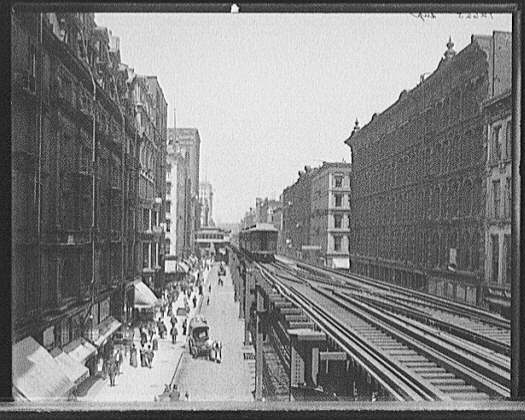
The Appeal of Chicago
Numerous women moved to Chicago during the late nineteenth and early twentieth century. The majority of these individuals were single women in search of better lives for themselves (6). As Joanne Meyerowitz describes in her book, Women Adrift, the lure of employment in Chicago brought women to the big city as a means to accomplish these goals (10).
In Meyerowitz's book, she describes an abundance of women who moved to Chicago in search of a better life. Thus, when Caroline Meeber boards the train in Sister Carrie that takes her from Columbia City to Chicago , she sets out on a journey with many other women of her time. Although Dreiser reveals at the outset of her adventure that she is “full of the illusions of ignorance and youth" (4), Carrie's expectations for opportunity in Chicago are far from unique.
Wabash Ave. 1900

Meyerowitz notes that the increased labor force was an impetus for the surge of women to Chicago . The demand for labor was greatest in the cities as the twentieth century began, and the female labor force in Chicago increased from 35,600 to 407,600 from 1880 to 1930 (10). Thus, when Carrie's brother in law informs her that “[ Chicago ] is a big place,” and she can find work in a few days because “[everybody] does,” he is alluding to the rapid growth of the labor force during this time (4).
Although the same desire for work could be found in most of the women moving to Chicago , the causes of their desires varied. Some women, such as Carrie, ventured to the city “in search of the keener pleasures in life” (4). Meyerowitz reveals, however, that women came to the city for a variety of reasons. She states that women:
left home because parents, husbands, or kin could not or would not contribute to their support; because they needed work and could not find jobs nearby; because death, divorce, or desertion had disrupted their families; because they had ambition; because they felt stigmatized, abused, unwanted, or unhappy at home (10).
As Meyerowitz's list reveals, the reasons for the large influx of women into Chicago were varied and circumstantial. Some women came for necessity while others came for desire, and some came for individual betterment while others made an attempt to help their families with economic support.

The women moving to Chicago were not only varied in their motives, but were also varied in their places of origin. Carrie's move from a small village in the countryside to the big city paralleled the large stream of white women that came from the countryside around Chicago , including areas of Illinois, Wisconsin, Indiana, Ohio, Michigan, Iowa, and Missouri (10). Although the majority of white native-born female migrants in Chicago in 1910 were from the Midwest , a large proportion were also from the Northeast. Individuals from the South and West comprised less than 14% of these migrants. The majority of black native born migrants, however, came from the South. At this time, a proportion of foreign born migrants to Chicago were coming from countries including Canada, England, Scandinavia, Germany, and Ireland. The majority of immigrants came from Poland, Lithuania, and Russia (10).
The mixture of women who moved to Chicago at the turn of the twentieth century reveals an abundance of motives and circumstances that all lead to one goal: a different life. Women took on the city to find jobs and opportunities that they were not able to find elsewhere.
In light of their ambitions, the question arises as to whether or not the women's dreams could be fulfilled in the city that Dreiser describes as “a metropolitan center,” which “possessed a high and mighty air calculated to overawe and abash the common applicant, and to make the gap between poverty and success seem both wide and deep” (4). Thus, although Chicago seemed to be a source of opportunity, the average woman was faced with a mixture of prospect and failure as she began her attempts at a better life.
In order to gain insight into the various options for a woman at this time in Chicago , it is necessary to go to the source of her possible success: employment. Various occupations may be chosen as you take an even closer look at Chicago from the train station. Will you traverse the gap to success? Or will there be too many obstacles in your way? Take a closer look to find out: HOME